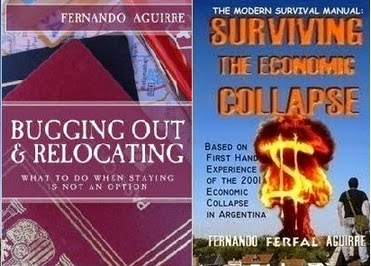"2 units of sugar maximum per purchase"
Fernando:
Thought you might be interested in the following from New York City's FOX TV station yesterday if you didn't see it already:
"...Argentines are falling back on tried and true survival skills to cope with the turmoil."
"Argentines jockey to cope with economic turmoil"
Sorry to hear about what's going on back in Argentina these
days.
Have a nice weekend,
Argentines jockey to cope with economic turmoil
Posted: Jan 30, 2014 1:42 PM Updated: Jan 30, 2014 1:42 PM
ALMUDENA CALATRAVA and DEBORA REY
BUENOS AIRES, Argentina (AP) — Consumer prices are soaring, the treasury is running low on foreign currency and the peso has had its sharpest slide in 12 years. Instead of rioting, though, Argentines are falling back on tried and true survival skills to cope with the turmoil.
Inflation is at about 30 percent and there's been a 15 percent drop in the peso's value against the U.S. dollar over a few days. But Argentina has gone through five much more dire economic times since the 1930s.
So some Argentines are hoarding dollars, while others stockpile goods or plow their savings into real estate.
More people ride bikes now following recent increases in public transportation fares. They eat less at restaurants and cook at home. They buy cheap, pirated DVD copies of the latest films rather than go to the cinema.
Sofia Basualdo, a 43-year-old geography teacher, responded to growing inflation with a shopping spree to beat further price rises.
"I might pay one peso for a product today, but next week I'll likely have to pay two pesos," Basualdo said as she left a Buenos Aires supermarket pushing a shopping cart filled to the brim. "In this country, when you start smelling inflation it's best to buy and save."
Many Argentines note that the current economic woes are not as bad as Argentina's financial collapse in 2001-2002. Unemployment remains relatively low, and many people benefit from government handouts. Yet they worry the country may be at a tipping point.
"People are adopting defensive measures to survive," said Jorge Raventos, a political analyst and former spokesman for Argentina's foreign relations ministry. "People endure this by zig-zagging along, but it's hard to know how much they can take before they explode."
Although it is exceedingly difficult because of strict regulations, some people and businesses have succeeded in past years in sending their dollars out of Argentina as a hedge against inflation. Then Deputy Economy Minister Axel Kiciloff last year estimated Argentine individuals and companies had socked away up to $200 billion in undeclared currency outside the country.
But like most people, Carlos Partcha, an 80-year-old retired journalist, has taken the simpler measure of buying U.S. dollars and stashing them under his mattress — as he has done for more than a decade.
"We don't trust anything anymore. Not even the banking institutions," Partcha said. "I had saved in dollars, and when the banks froze deposits in 2001, I got pesos back and lost my money."
BUENOS AIRES, Argentina (AP) — Consumer prices are soaring, the treasury is running low on foreign currency and the peso has had its sharpest slide in 12 years. Instead of rioting, though, Argentines are falling back on tried and true survival skills to cope with the turmoil.
Inflation is at about 30 percent and there's been a 15 percent drop in the peso's value against the U.S. dollar over a few days. But Argentina has gone through five much more dire economic times since the 1930s.
So some Argentines are hoarding dollars, while others stockpile goods or plow their savings into real estate.
More people ride bikes now following recent increases in public transportation fares. They eat less at restaurants and cook at home. They buy cheap, pirated DVD copies of the latest films rather than go to the cinema.
Sofia Basualdo, a 43-year-old geography teacher, responded to growing inflation with a shopping spree to beat further price rises.
"I might pay one peso for a product today, but next week I'll likely have to pay two pesos," Basualdo said as she left a Buenos Aires supermarket pushing a shopping cart filled to the brim. "In this country, when you start smelling inflation it's best to buy and save."
Many Argentines note that the current economic woes are not as bad as Argentina's financial collapse in 2001-2002. Unemployment remains relatively low, and many people benefit from government handouts. Yet they worry the country may be at a tipping point.
"People are adopting defensive measures to survive," said Jorge Raventos, a political analyst and former spokesman for Argentina's foreign relations ministry. "People endure this by zig-zagging along, but it's hard to know how much they can take before they explode."
Although it is exceedingly difficult because of strict regulations, some people and businesses have succeeded in past years in sending their dollars out of Argentina as a hedge against inflation. Then Deputy Economy Minister Axel Kiciloff last year estimated Argentine individuals and companies had socked away up to $200 billion in undeclared currency outside the country.
But like most people, Carlos Partcha, an 80-year-old retired journalist, has taken the simpler measure of buying U.S. dollars and stashing them under his mattress — as he has done for more than a decade.
"We don't trust anything anymore. Not even the banking institutions," Partcha said. "I had saved in dollars, and when the banks froze deposits in 2001, I got pesos back and lost my money."
Read more: http://www.myfoxny.com/story/24588158/argentines-jockey-to-cope-with-economic-turmoil#ixzz2s1PtBJmY
Follow us: @myfoxny on Twitter | Fox5NY on Facebook










